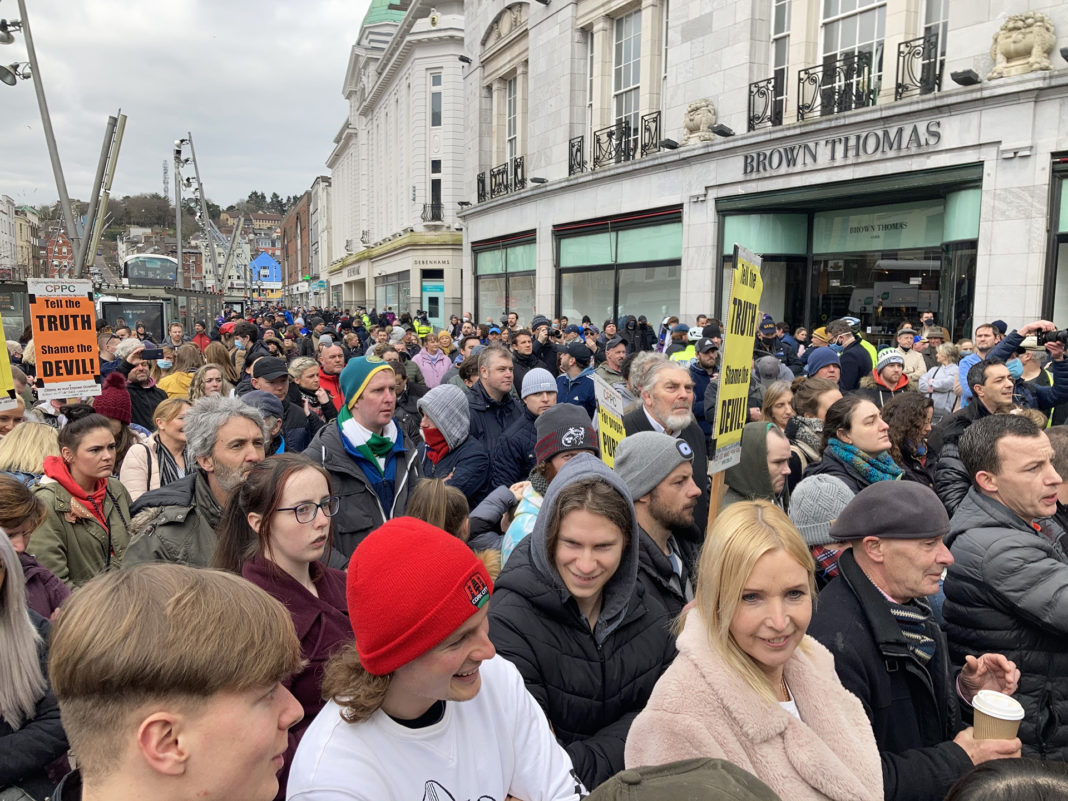For a year now Covid-19 has shown us how fragile our daily reality is, and some of us are finding comfort in conspiracy theories and lies which put a reassuring shape on a frightening world.
I attended last Saturday’s protest in Cork city centre against the lockdown, and – despite the precedent set a week before in Dublin, when a garda had a firework aimed at and fired in his face – it was mostly a good-natured gathering.
The protest had gone ahead despite appeals from across the political spectrum, and from business and community leaders, to cancel the event. There was a heavy garda presence, with over 200 uniformed gardaí in attendance, as well as plainclothes officers and the garda helicopter hovering overhead.
The Irish Examiner put the attendance figure at “at least 450”. One garda told me afterward that while they had had a “comprehensive” plan in place in the event of violence, and with only six arrests, they were “delighted” that the event had passed peacefully.
Despite assurances given beforehand by the protest’s organiser, former county councillor Diarmaid O Cadhla of a group called “the Cork’s People’s Convention”, stewarding and social distancing were non-existent at the event, and almost nobody there – bar the gardaí and the media – wore masks. (O Cadhla first came to my attention when he was prosecuted over a campaign to black out the word “Victoria” from Cork street signs.)
The lack of social distancing might be explained by the amateurish set-up of the protest – the podium was four Bulmers crates, and the amplification was rubbish.
The lack of masks, though, was deliberate, and a clear political decision. I saw in the crowd a lot of hugs, a lot of handshakes, and I recognised a lot of faces, some of them people badly served by Irish society, some of them homeless, some of them “pro-life”, some of them anti-vaccine New Age types – a journalist friend commented afterwards “There must be no-one left in Skibbereen today”.
I also recognised some of them from the night two years ago when failed election candidate Gemma O’Doherty was turned away from a planned meeting in An Spailpín Fánach.
There was the big lad who had told me that night that he was opposed to abortion, and all immigration, legal and illegal, as he feared “the great replacement” which, he said, would see “all the white people” removed from Ireland.
There was the man with the dyed hair and the sort of intense stare the late Anthony John Soprano Sr called “Manson lamps”, who told me in the Spailpín that “the non-Irish” are taking over the country, and he wanted to “cut George Soros’ f***ing throat”.
There was the man I recognised as having verbally abused someone canvassing with me in the city centre for marriage equality in 2015, spitting at him that he was a “f****t”.
The meeting was rounded off by Our Father sung as Gaeilge, and a rendition of the national anthem. If the majority of the crowd seemed to have a shaky enough grasp of the lyrics, they more than made up for that with a spirited expectoration of the general gist of it.
On the fringes of the crowd, I had a very pleasant conversation with John Bowler, a Kerry-based Californian with a nicotine-white walrus moustache and a green “Make Ireland Great Again” cap. John received 0.61% of the Kerry vote for the far-right Irish Freedom Party in last year’s general election. He told me he was delighted with the turnout.
“I came from Tralee, which is of course illegal, we were gonna take the train, and there were four garda outside the train station trying to prevent people from coming to the event. Instead, we took the bus and ended up kinda low-sliding in below the radar.”
A man named Matt, bearing a placard saying “RTÉ is the virus”, told me he has watched every Late Late Show from the start of January of 2020 to March of 2020. He said of all the guests on those shows, only three people spoke about mental health, and well-being. “It’s totally biased. There is no room for the opposite side.” I wasn’t sure I quite understood his point about the Late Late, but he seemed a very nice man.
The Government, medics and “big pharma” were frequently singled out as being completely untrustworthy, and a distrust of mainstream media was a common refrain among those attending. I was standing beside RTÉ’s Brian O’Connell as two very respectable-looking women laid into him, demanding he “report the truth”. The mild-mannered O’Connell assured them he would continue to do so.
Róisín Burke of The Echo reported seeing in the crowd an “Irish Lives Matter” placard.
Speaker after speaker accused the Government of lying, and Diarmaid O Cadhla claimed “the numbers are exaggerated”. This was greeted with a chant from the crowd of “Scamdemic”. One speaker, Paddy Bulman from Youghal, got a massive cheer when he said the Government is not trying to stop the spread of a deadly disease, but rather “the spread of the truth”.
I couldn’t see him in the crowd, but one man was randomly shouting words like “murderers”, “robbers”, and “fake news”, getting a cheer every time. I joked on Twitter that I could swear it was Billy Murphy from The Young Offenders. As one speaker listed off a crowd-pleasing litany of public scandals, from mother and baby homes to the bank guarantee, Billy yelled “Paedo-gate”.
That earned a muted enough reaction from the crowd because – I suspect – most people there might not yet be far enough down the internet conspiracy theory rabbit hole which inevitably leads to lizard people harvesting children, as witness the two women attending the previous week’s Dublin protest in matching t-shirts reading “Save our children from the reptilians”.
Speaking to Mark Tighe of the Sunday Times, they outlined a theory that RTÉ presenters are murdering children to harvest a hormone – adrenochrome – which they then use to make themselves look youthful.
This, of course, is just an Irish cover-version of QAnon, the ludicrous conspiracy theory which has swept the extremes of the US Republican party, with the likes of Barack Obama, Hillary Clinton, and Joe Biden cast as paedophile vampires. QAnon is a lazy, 21st century, internet reworking of the ancient anti-Semitic blood libel lie which pretended Jews murder gentile children to use their blood to make matzo bread for Passover.
Conspiracy theories have always been with us, and Adolf Hitler loved the “Protocols of the Elders of Zion”, a 1903 anti-Semitic forgery which popularised the notion of a worldwide Jewish conspiracy to control press and banking. Historian Nora Levy said “Hitler used the Protocols as a manual in his war to exterminate the Jews”.
The high-ranking Nazi Erich von dem Bach-Zelewski later admitted that there was no conspiracy, no Jüdische Gefahr (“Jewish Menace”). “In reality, (Jews) had no organisation at all, not even an information service. If they had had some sort of organisation, these people could have been saved by the millions, but instead, they were taken completely by surprise.”
In his 2010 book, Voodoo Histories: The Role of the Conspiracy Theory in Shaping Modern History, David Aaronovitch debunks many popular conspiracy theories and asks why well-educated, reasonable people sometimes believe “perfectly ridiculous things”.
Key common characteristics of conspiracy theories, Aaronovitch says, tend to be politically populist, paranoid and granted a veneer of respectability by selective quotations from often dubiously-qualified academics (“death by footnote”).
Conspiracy theories usually claim to lay bare the actions of a small power elite. Belief in the conspiracy makes you part of a heroic group who can see past the official version propagated by the powers that be. Those who cannot or will not see “the truth” can be dismissed as “sheeple”.
It’s been a year now since the world stopped, and Covid-19 showed us all just how fragile our daily reality is, and how easily the solid ground beneath our feet can fall away. Small wonder then that in our rage and loneliness some are finding comfort in conspiracy theories and lies which put a reassuring shape on a frightening world.
We have a ways to go yet before we’re out of this, and more of us may yet find our grip on a shared reality fraying badly before we finally do get home.








